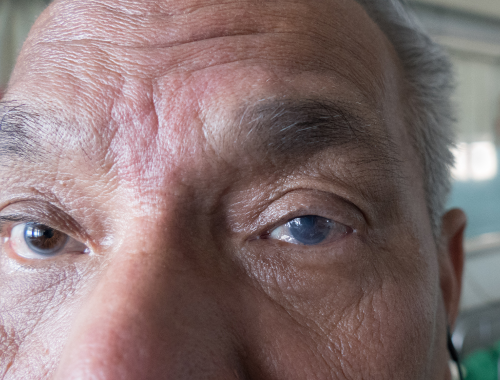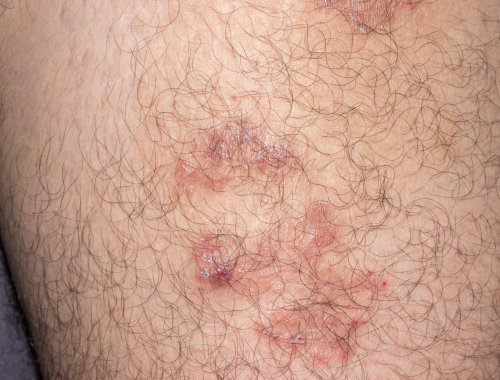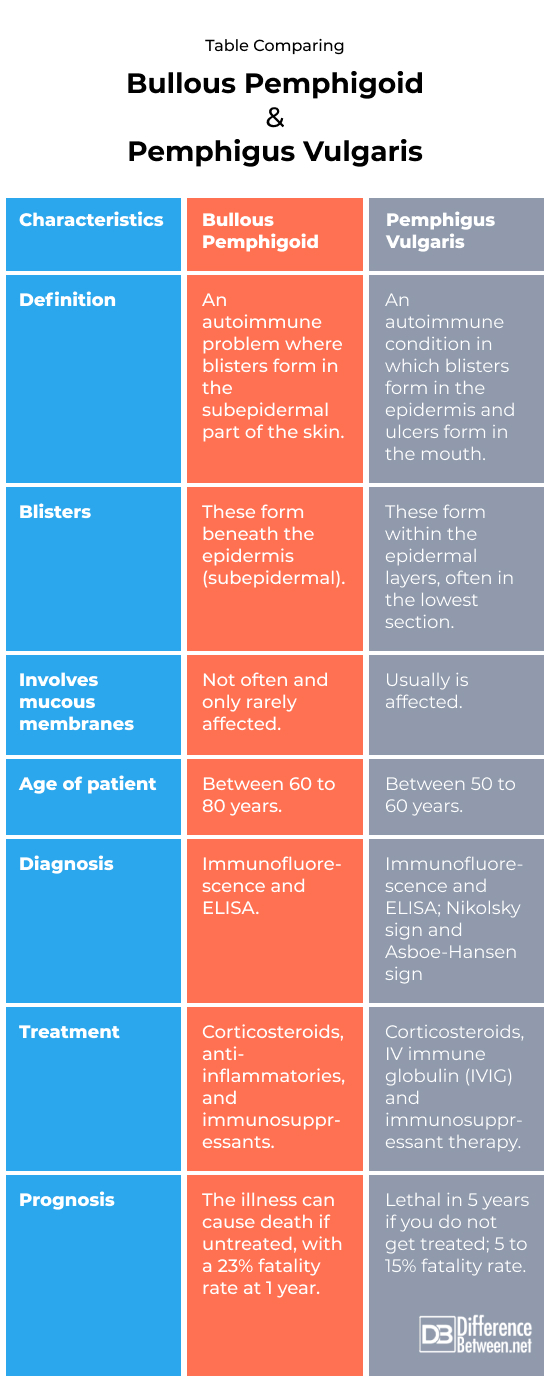Difference Between Bullous Pemphigoid and Pemphigus Vulgaris
Bullous pemphigoid is a blistering of the skin under the outer layers. Pemphigus vulgaris is a condition where blisters form in the epidermis and sores form in the mucous membranes.

What is Bullous pemphigoid?
Definition:
An autoimmune problem resulting in blisters forming below the epidermis of the skin.
Causes and prevalence:
Bullous pemphigoid may be triggered by a number of factors including radiation therapy, herpes viruses, hepatitis viruses, and certain medications. The condition is not common with about 23 cases for every million people.
Symptoms:
Symptoms of the condition include itching of the skin and the development of large fluid-filled blisters known as bullae. Variable types of lesions occur; some are red swollen blotches while others are blisters filled with fluid. Blisters may occur where there has been a trauma to the skin like at the site of a stoma and in areas where the skin flexes (armpits, upper part of the thighs, and lower abdominal region).
Complications:
Complications of bullous pemphigoid include bacterial infections of the skin, notably of Staphylococcus or Streptococcus. The infections can lead to sepsis, which can be life-threatening. Herpes simplex and H. zoster viral infections are more likely if you have bullous pemphigoid.
Diagnosis:
Diagnosis is done by a skin biopsy and then viewing the sample with direct immunofluorescence (IF) microscopy. Specific enzyme-linked immunosorbent assays (ELISAs) are also used in diagnosing the condition.
Treatment:
Treatment includes using anti-inflammatory drugs, corticosteroids such as clobetasol 0.05% as a topical cream, and oral prednisone. Immunosuppressant medication may be used as well.

What is Pemphigus vulgaris?
Definition:
A disorder where blisters form inside in the lower areas of the epidermis of the skin and ulcerations occur on mucous membranes.
Causes and prevalence:
Pemphigus vulgaris is due to an autoimmune reaction in which the immune system attacks healthy cells. This condition occurs in 0.5 to 3.0 of every 100,000 people.
Symptoms:
The blisters break apart easily, are painful, and surrounded by reddened patches of skin. Ulcers occur in mucosal membranes such as the mouth making it difficult to eat.
Complications:
People may lose weight because of the painful eating. Another complication is infection and later, sepsis, which can occur if the condition remains untreated.
Diagnosis:
Diagnosis is based on the physical signs and the results of a skin biopsy and immunofluorescence test and enzyme-linked immunosorbent assay (ELISA). There are tests on the characteristics of the lesions. These are the Nikolsky sign and Asboe-Hansen sign. In the former case, skin moves sideways when pressed and in the latter case, fluid in a blister moves when it is pressed.
Treatment:
Treatment is important because this illness will cause death if not controlled. Doctors usually prescribe immunosuppressive and also systemic corticosteroids. These medications can help reduce the overactive immune system and resultant inflammatory response.
Difference between Bullous pemphigoid and Pemphigus vulgaris?
Definition
Bullous pemphigoid is an autoimmune problem where blisters form in the subepidermal part of the skin. Pemphigus vulgaris is an autoimmune problem where blisters form in the epidermal part of the skin and ulcers form in the mouth.
Blisters
Blisters of bullous pemphigoid are subepidermal. Blisters of pemphigus vulgaris are in the epidermal layer.
Involves mucous membranes
In the case of bullous pemphigoid, it is very rare for mucous membranes to be involved. In the case of pemphigus vulgaris, mucous membranes are involved with ulcers forming in the mouth.
Age of patient
Mostly patients between 60 to 80 years are prone to bullous pemphigoid. Mostly patients between 50 to 60 years are afflicted with pemphigus vulgaris.
Diagnosis
The diagnosis of bullous pemphigoid relies on immunofluorescence and ELISA tests. The diagnosis of pemphigus vulgaris is done by looking for the Nikolsky sign and Asboe-Hansen sign and by doing an immunofluorescence and ELISA tests.
Treatment
Bullous pemphigoid is treated by using a combination of corticosteroids, anti-inflammatories, and immunosuppressant medications. Pemphigus vulgaris is treated by using a combination of corticosteroids, IV immune globulin (IVIG), and immunosuppressant therapy.
Prognosis
Bullous pemphigoid can cause death if untreated; with a rate of 23% fatality at one year. Pemphigus vulgaris can be lethal in 5 years if you do not get treated; fatality varies from 5% to 15%.
Table comparing Bullous pemphigoid and Pemphigus vulgaris

Summary of Bullous pemphigoid Vs. Pemphigus vulgaris
- Bullous pemphigoid and pemphigus vulgaris are both skin conditions due to autoimmunity.
- Bullous pemphigoid also causes ulcers in the mouth.
- Pemphigus vulgaris occurs in middle-aged people while bullous vulgaris occurs in elderly people.
FAQ
What is worse pemphigus vulgaris or bullous pemphigoid?
Pemphigus has worse symptoms because it is a more severe disease, but both can cause death if untreated. Bullous pemphigoid has a higher death rate though.
What is the difference between pemphigus and pemphigoid?
Pemphigus conditions have shallow ulcers that easily break while pemphigoid conditions are those with deeper ulcers that do not easily rupture.
What is the difference between pemphigus and vulgaris?
Pemphigus means skin blisters and vulgaris means common.
What are 2 signs of pemphigus vulgaris?
Having blisters or ulcers in the mouth is one sign of pemphigus vulgaris, the other is having skin blisters.
What triggers bullous pemphigoid?
Several disorders can trigger this condition including having psoriasis, diabetes, or rheumatoid arthritis.
What makes bullous pemphigoid fatal?
The skin blisters can become infected and this can lead to sepsis, shock, and death.
- Difference Between Rumination and Regurgitation - June 13, 2024
- Difference Between Pyelectasis and Hydronephrosis - June 4, 2024
- Difference Between Cellulitis and Erysipelas - June 1, 2024
Search DifferenceBetween.net :
Leave a Response
References :
[0]Moro, Francesco, et al. "Bullous pemphigoid: trigger and predisposing factors." Biomolecules 10.10 (2020): 1432.
[1]Peraza, Daniel M. “Bullous Pemphigoid”. Merckmanuals. Merck & Co., 2022, https://www.msdmanuals.com/professional/dermatologic-disorders/bullous-diseases/bullous-pemphigoid
[2]Peraza, Daniel M. “Pemphigus Vulgaris”. Merckmanuals. Merck & Co., 2022, https://www.msdmanuals.com/professional/dermatologic-disorders/bullous-diseases/pemphigus-vulgaris
